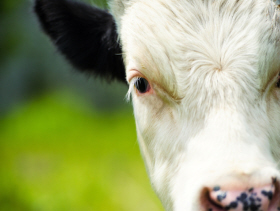



Can Grazing Systems Produce High Quality Beef Without Increasing Environmental Footprint?
ANALYSIS - Land unsuitable for crop production can be used as a source of human food through grazing, writes Chris Harris.And well-managed permanent grasslands used for grazing livestock can lock up atmospheric carbon in the soil, because the grassland has a permanent plant cover and in this way can be seen as a sustainable way of rearing livestock for meat.
A research project by Rothamsted Research, the University of Exeter, University of Bristol and the University of Reading has taken these concepts as the central part of the study to investigate the true impact of meat production.

The research team is looking at how ruminants can provide high quality nutrients without increasing the environmental footprint of agriculture.
The project based at the North Wyke Farm Platform and funded by the Biotechnology and Biological Sciences Research Council (BBRSC) is one of 15 new scientific research projects in the UK that is being showcased at the 2015 Royal Society Summer Science Exhibition in London.
The research is also art of the Global Farm Platform, led by the University of Bristol, which aims to discover the optimum grazing livestock production systems on a worldwide basis.
The North Wyke Farm Platform, located near Okehampton in Devon has been divided into three different experimental grazing “farmlets”, each with five fields, each hydrologically isolated by large-scale drainage schemes.
One of the small farms has permanent pasture, another legumes for which white clover has been used, and a third with new grass varieties.
The new grass variety that is being used at the present stage of the research is mixture of monoculture grasses that are high sugar grasses to improve microbial synthesis. The mix being used is a rye grass together with a fescue deep rooted grass.
Each of the different “farmlets” is grazed by its own livestock herd. At present for cattle the team is using Hereford Friesian suckler cattle crossed with a Charolais bull.
The team looks at the amount of meat produced per hectare, the quality of the meat by looking at the nutrients in it per hectare, the health of the animals, the gas emissions and the water and soil inputs and outputs.
All this different data is collected and compared between the “farmlets” to discover the best performers.
Prof Michael Lee, (pictured) who is heading up the research, said that the fields are designed so that the water run-off can be collected and is tested in on-field specially constructed laboratories to assess the levels of nitrogen and ammonia and other nutrients.

The labs also test changes in soil carbon, nitrogen and phosphorous, pH and bulk density and an on-line weather station and soil probe on each “farmlet” soil moisture and temperature, which relates to pasture growth and livestock production. Measures.
He said that the fescue grass was chosen in the innovation field because of its deep root systems that helps to break up the soil and allows deeper penetration and collection of water.
“The benefits of designing environmentally optimal livestock grazing systems may include the reduced need for fertiliser application, increased production and nutritional quality, low gas emissions and the support of biodiversity and the provision of ecosystem services.”
By concentrating on grazing livestock and the different types of forage the team can assess the efficiency of the conversion to meat, while at the same time assessing the environmental impact.
Prof Lee said that cattle vane not been grown to be highly efficient with nitrogen.
But the gut microbes that produce methane and ammonia gases also allow cattle to convert feed that is not suitable for human consumption into high quality nutritious meat.
And he added that the type of grass or forage the animals received, which is also in their silage when the animals are brought inside for the winter, helps to determine the quality and the nutrients in the meat and the muscle quality and conformation.
The animal dung and slurry is a source of free, organic fertiliser containing carbon and nutrients.
He said that grazing systems have to be carefully designed to reduce the need for fertiliser application and also to balance energy and protein release in the cattle to minimise methane and ammonia loss.
Prof Ian Givens from the University of reading said that there are many things that can happen in the food chain before the meat comes to the supermarket that can have a bearing on the quality of the meat.
At present one way to reduce the greenhouse gas emissions from beef production is to feed cattle with high energy and protein diets consisting of cereals and soya.
But this has other impacts as these grains are used for human consumption and also have environmental impacts of their own to be considered.
One of the aspects that influence the quality of the meat and the nutrients with in it are in the feed and pasture of the animals.
| Criteria | Measure | Units |
| Animal performance | Daily weight gain | Kg weight gain/day |
| Carrying capacity | Animals per hectare | Kg weight/ha |
| Nutritional quality | Nutrients per hectare (e.g. calories, protein, minerals) | Kg nutrient/ha |
| Nutrient and soil loss to water | Losses per hectare per day | Kg/ha/day |
| Greenhouse gas emissions | CO2 (or equivalent) per unit of animal product | Kg CO2 eq/kg product |
| Animal health and welfare | Costs of preventative veterinary care and treatment of diseases | Veterinary costs (£) |
| Biodiversity | Range of wildlife and species | Species/ha |
| Inputs (fertiliser, machinery, labour) | Purchase cost | £ |
| Outputs (beef cattle) | Sales value | £ |
Research at the University of Reading associated with the North Wyke Farm project is looking at ways to reduce levels of saturated fats being produced by cattle.
Prof Givens said there was a need to show the benefits of red meat within the diet and he said there are concerns about the lack of some minerals in the diet of women because of a lack of red meat in the diet – notably a lack of iron.
Prof Lee said the research would be positioning red meat in terms of food security.
The project is due to run until 2017. At present, it is establishing the first set of data, but Prof Lee said he would like to see the research continue in other areas, including comparisons with feedlot feed systems.
He added that the results could show one particular form of livestock grazing to be better than others or it could indicate a mix of the feeding systems would be most beneficial.
However, he said there was more work to do in the study and it was opening up other areas of research for the future.
The team is also looking at similar research in sheep production and different grazing systems.


